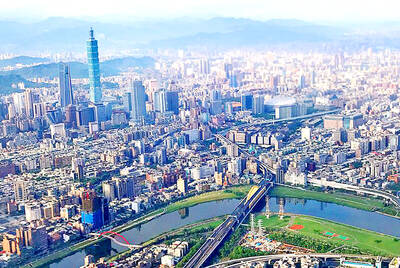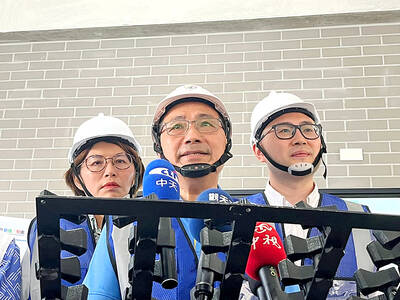Fengtien Temple (奉天宮) in Chiayi County’s Hsinkang Township (新港) on Wednesday sealed its bell and drum in preparation for Ghost Month — the seventh month of the lunar calendar, which began yesterday.
On the first and last days and the 14th and 15th of each month on the lunar calendar, the bell is rung and the drum is beaten as a sign of respect for the gods, temple chairman Ho Ta-huang (何達煌) said.
However, during Ghost Month, the practice is forbidden to avoid scaring the ancestors and ghosts who are visiting from the underworld, said Ho, who led the ritual.

Photo courtesy of Fengtien Temple
The tradition of sealing the bell and drum has existed for hundreds of years, he said, adding that it originates from when the temple was in the county’s Bengang (笨港) area and demonstrates Matsu’s benevolence.
The ritual began in the morning with a scripture recital and prayer for the gods to ward off disaster and to protect believers, the temple said.
After the bell and drum are sealed, the temple also stops lighting firecrackers and reciting scriptures for the entire month, it said.
The bell and the drum are to be unsealed on the morning of the first day of the eighth month on the lunar calendar, which is Aug. 30 this year, the temple said.
The temple is to host ceremonies from Monday to Wednesday next week to help people remove bad luck and pray for blessings.

Taipei has once again made it to the top 100 in Oxford Economics’ Global Cities Index 2025 report, moving up five places from last year to 60. The annual index, which was published last month, evaluated 1,000 of the most populated metropolises based on five indices — economics, human capital, quality of life, environment and governance. New York maintained its top spot this year, placing first in the economics index thanks to the strength of its vibrant financial industry and economic stability. Taipei ranked 263rd in economics, 44th in human capital, 15th in quality of life, 284th for environment and 75th in governance,

Greenpeace yesterday said that it is to appeal a decision last month by the Taipei High Administrative Court to dismiss its 2021 lawsuit against the Ministry of Economic Affairs over “loose” regulations governing major corporate electricity consumers. The climate-related lawsuit — the first of its kind in Taiwan — sought to require the government to enforce higher green energy thresholds on major corporations to reduce emissions in light of climate change and an uptick in extreme weather. The suit, filed by Greenpeace East Asia, the Environmental Jurists Association and four individual plaintiffs, was dismissed on May 8 following four years of litigation. The

A former officer in China’s People’s Liberation Army (PLA) who witnessed the aftermath of the 1989 Tiananmen Square massacre has warned that Taiwan could face a similar fate if China attempts to unify the country by force. Li Xiaoming (李曉明), who was deployed to Beijing as a junior officer during the crackdown, said Taiwanese people should study the massacre carefully, because it offers a glimpse of what Beijing is willing to do to suppress dissent. “What happened in Tiananmen Square could happen in Taiwan too,” Li told CNA in a May 22 interview, ahead of the massacre’s 36th anniversary. “If Taiwanese students or

The New Taipei City Government would assist relatives of those killed or injured in last month’s car-ramming incident in Sansia District (三峽) to secure compensation, Mayor Hou You-yi (侯友宜) said yesterday, two days after the driver died in a hospital. “The city government will do its best to help the relatives of the car crash incident seek compensation,” Hou said. The mayor also said that the city’s Legal Affairs, Education and Social Welfare departments have established a joint mechanism to “provide coordinated assistance” to victims and their families. Three people were killed and 12 injured when a car plowed into schoolchildren and their